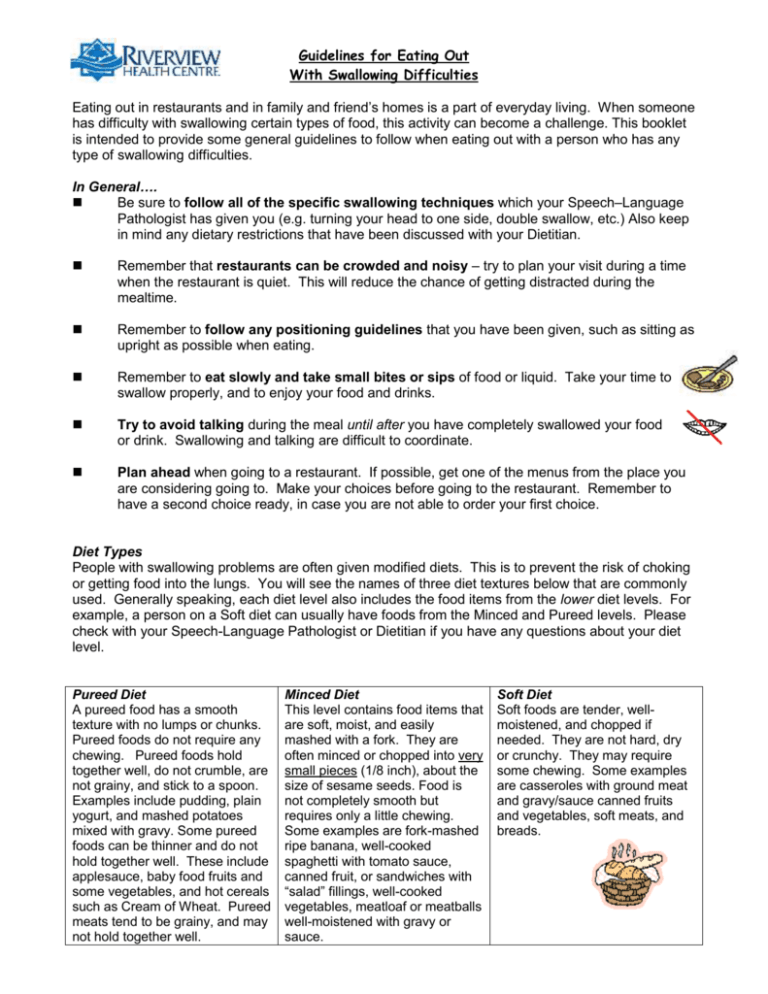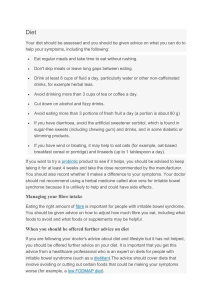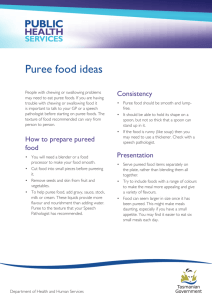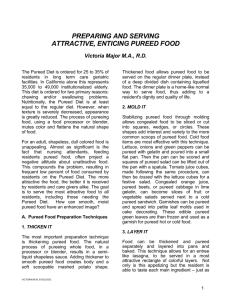Guidelines for Eating Out
advertisement

Guidelines for Eating Out With Swallowing Difficulties Eating out in restaurants and in family and friend’s homes is a part of everyday living. When someone has difficulty with swallowing certain types of food, this activity can become a challenge. This booklet is intended to provide some general guidelines to follow when eating out with a person who has any type of swallowing difficulties. In General…. Be sure to follow all of the specific swallowing techniques which your Speech–Language Pathologist has given you (e.g. turning your head to one side, double swallow, etc.) Also keep in mind any dietary restrictions that have been discussed with your Dietitian. Remember that restaurants can be crowded and noisy – try to plan your visit during a time when the restaurant is quiet. This will reduce the chance of getting distracted during the mealtime. Remember to follow any positioning guidelines that you have been given, such as sitting as upright as possible when eating. Remember to eat slowly and take small bites or sips of food or liquid. Take your time to swallow properly, and to enjoy your food and drinks. Try to avoid talking during the meal until after you have completely swallowed your food or drink. Swallowing and talking are difficult to coordinate. Plan ahead when going to a restaurant. If possible, get one of the menus from the place you are considering going to. Make your choices before going to the restaurant. Remember to have a second choice ready, in case you are not able to order your first choice. Diet Types People with swallowing problems are often given modified diets. This is to prevent the risk of choking or getting food into the lungs. You will see the names of three diet textures below that are commonly used. Generally speaking, each diet level also includes the food items from the lower diet levels. For example, a person on a Soft diet can usually have foods from the Minced and Pureed levels. Please check with your Speech-Language Pathologist or Dietitian if you have any questions about your diet level. Pureed Diet A pureed food has a smooth texture with no lumps or chunks. Pureed foods do not require any chewing. Pureed foods hold together well, do not crumble, are not grainy, and stick to a spoon. Examples include pudding, plain yogurt, and mashed potatoes mixed with gravy. Some pureed foods can be thinner and do not hold together well. These include applesauce, baby food fruits and some vegetables, and hot cereals such as Cream of Wheat. Pureed meats tend to be grainy, and may not hold together well. Minced Diet This level contains food items that are soft, moist, and easily mashed with a fork. They are often minced or chopped into very small pieces (1/8 inch), about the size of sesame seeds. Food is not completely smooth but requires only a little chewing. Some examples are fork-mashed ripe banana, well-cooked spaghetti with tomato sauce, canned fruit, or sandwiches with “salad” fillings, well-cooked vegetables, meatloaf or meatballs well-moistened with gravy or sauce. Soft Diet Soft foods are tender, wellmoistened, and chopped if needed. They are not hard, dry or crunchy. They may require some chewing. Some examples are casseroles with ground meat and gravy/sauce canned fruits and vegetables, soft meats, and breads. Thickened Liquids The consistency of these liquids is thicker, and safer to swallow for some individuals. A thickener must usually be used to get this consistency, and there are very few that can be ordered in a restaurant. If your diet includes thickened liquids, it is recommended that you discuss this with your Speech-Language Pathologist or Dietitian. Thin Liquids These are regular liquids, which are very thin and do not stick to a spoon. Examples are water, juice, milk, pop, coffee and tea. Here are some common examples of different diet textures found at some restaurants. This can help to select appropriate foods when dining out. If in doubt about any item, ask your SLP. Fast Food Restaurant (McDonald’s, Burger King, etc.) Pureed Diet: No pureed items are available Minced Diet: Pancakes with syrup mashed with a fork Scrambled eggs mashed with a fork Fish sandwich moistened with tartar sauce and mashed with a fork Baked potato with toppings, mashed with a fork French fries moistened with ketchup, mashed with a fork Soft Diet: Hamburger or cheeseburger (no bacon, lettuce, onion or tomato), cut up into small pieces and moistened with ketchup, etc. Chicken nuggets cut into small pieces, moistened with sauce French fries or hash browns with ketchup Family Restaurants (Smitty’s, Perkins, The Keg, etc.) Pureed Diet: Oatmeal, Cream of Wheat cereal Applesauce Mashed potatoes with gravy Thick creamed soups with no vegetable or meat chunks Minced Diet: Eggs, any style, mashed with a fork Meatloaf with gravy Well cooked vegetables with sauce, mashed with a fork Pasta with sauce, mashed with a fork Fish, soft and well cooked, moistened and mashed with a fork Soft Diet: Meat Sandwich, with small meat pieces, moistened with sauce, with soft bread pieces (avoid French bread, Kaiser buns, etc.) Macaroni and Cheese Turkey, Chicken or beef, cut into small pieces and moistened with sauce Lasagne or other pastas, with extra sauce, cut in small pieces Pizza with a soft, thin crust, with cheese and sauce only, cut into small pieces Chili or soups without large chunks of meat or vegetables Chinese/Asian Restaurants Pureed Diet: No pureed items are available Minced Diet: Soft, well-cooked fish or other meat, moistened and mashed with a fork Soft noodles without vegetables or meat, moistened and mashed with a fork Soft Diet: Soft, well cooked vegetables or noodles Steamed rice if well mixed with gravy or a sauce to hold together Won ton soup with noodles cut into small pieces Beverages Thickened Fluids: Some tomato, vegetable or nectar juices may be thick enough Some milkshakes which remain thick while drinking **All other liquids will require manual thickening**









